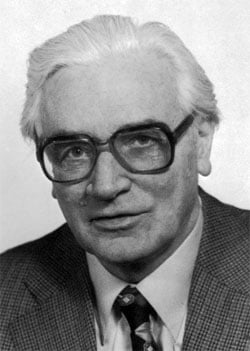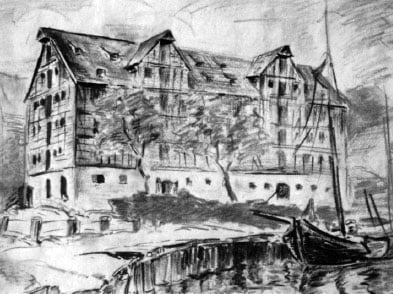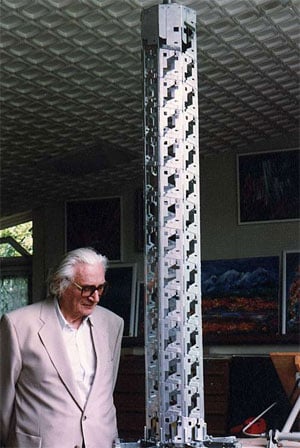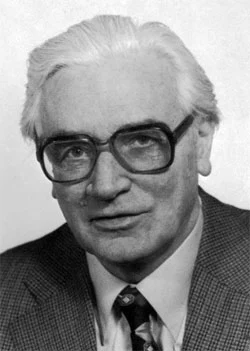Key Points
- Although Zuse was a talented artist, he opted to study civil engineering at the Technical College (Technischen Hochschule) in Berlin-Charlottenburg.
- In 1935 following his graduation, he was employed as a design engineer at the Henschel Flugzeugwerke (Henschel aircraft factory) in Berlin-Schönefeld. However, he resigned a year later deciding to build a computer.
- In spite of ups and downs, he is credited with the following: Using a binary number system for numbers and circuits, using floating point numbers, and the world’s first complete high-level language (Plankalkül).

Konrad Zuse
Konrad Zuse was born on 22 June 1910, in Berlin (Wilmersdorf), the capital of Germany, in the family of a Prussian postal officer — Emil Wilhelm Albert Zuse (26.04.1873-14.05.1946) and Maria Crohn Zuse (10.01.1882-02.07.1957). Konrad had a sister, two years older Lieselotte (1908-1953).

In 1912, the Zuse family left for Braunsberg, a sleepy small town in east Prussia, where Emil Zuse was appointed a postal clerk. From his early childhood, Konrad started to demonstrate a huge talent, not in mathematics, or engineering, but in painting (look at the fabulous chalk drawing nearby, made by Zuse in his school time).
Konrad went too young to the school and enrolled in the humanistic Gymnasium Hosianum in Braunsberg. After his family moved to Hoyerswerda (Hoyerswerda is a town in the German Bundesland of Saxony), he passed his Abitur (abitur is the word commonly used in Germany for the final exams young adults take at the end of their secondary education) at Reform-Real-Gymnasium in Hoyerswerda. After graduation, the young Konrad falls into a state of uncertainty about what to study later — engineering or painting. The film Metropolis of Fritz Lang from 1927 impressed pretty much Konrad. He dreamed of designing and building a giant and impressive futuristic city like Metropolis and even started to draw some projects. So finally he decided to study civil engineering at the Technical College (Technischen Hochschule) in Berlin-Charlottenburg.
During his studies, he worked also as a bricklayer and bridge builder. During this time the traffic lights were introduced into Berlin, causing chaos in the traffic. Zuse was one of the first people, who tried to design something like a “green wave”, but was unsuccessful. He was also very interested in the field of photography, and designed an automated system for the development of band negatives, using punch cards as accompanying maps for control purposes. Later on, he devised a special system for film projections, the so-called Elliptisches Kino
The next major project of the young dreamer was the conquest of space. He dreamed of building bases on the moons of the outer planets of the Solar System. In these bases will be built a fleet of rockets, each with a hundred or two hundred people passengers, capable of flying with a speed one thousand times the speed of light, so as to reach the nearest fixed star a thousand years away.
The future city Metropolis, the automatic photo lab, the elliptical cinema, the space project — all this is only a small part of the technical ideas, preparing the invention of the computer. After graduating from Technischen Hochschule in 1935, he started as a design engineer at the Henschel Flugzeugwerke (Henschel aircraft factory) in Berlin-Schönefeld, but resigned a year later, deciding to devote himself entirely to the construction of a computer. From 1935 till 1964 Zuse was almost entirely devoted to the development of the first relay computer in the world, the first workable programmable computer in the world (see computers of Zuse), the first high-level computer language in the world, etc.
In January 1945 Konrad Zuse married one of his employees — Gisela Ruth Brandes. On November, 17, the same year their first son Horst, was born. He will follow his eminent father and will get a diploma degree in electrical engineering and a Ph.D. degree in computer science. Later on were born Monika (1947-1988), Ernst Friedrich (1950-1979), Hannelore Birgit (1957) and Klaus-Peter (1961).
After 1964, the Zuse KG was no longer owned and controlled by Konrad Zuse. It was a heavy blow for Zuse to lose his company, but the active debts were too high. In 1967 he received another blow because the German patent court rejected his patent applications and Zuse lost his 26-year fight about the invention of the Z3 with all its new features (click here, to see Zuse’s first patent application from 1941).

An oil painting from Konrad Zuse (1979) (Source: www.epemag.com/zuse)
But in the 1960s the retired Zuse was still a man full of energy and ideas. He started to write an autobiography (published in 1970), made a lot of beautiful oil paintings (see the upper image), reconstructed his first computer (Z1), etc. In 1965, he was given the Werner von Siemens Award in Germany, which is the most prestigious technical award in Germany. In the same 1965, Zuse received the Harry Goode Memorial Award together with George Stibitz in Las Vegas.
In 1969 Zuse published Rechnender Raum, the first book on digital physics. He proposed that the universe is being computed by some sort of cellular automaton or other discrete computing machinery, challenging the long-held view that some physical laws are continuous by nature. He focused on cellular automata as a possible substrate of computation and pointed out that the classical notions of entropy and its growth do not make sense in deterministically computed universes.
In 1992 Zuse started his last project — the Helix-Tower (see the lower image), a variable-height tower, for catching wind in order to produce energy in an easier way, built from uniformly shaped and repeatable elements. The propeller and wind generator had to be mounted on the top of the tower. Zuse used a very elegant mechanical construction and immediately received a patent for this in 1993. The height of the tower could be modified by adding or subtracting building blocks.

Konrad Zuse with the project of his Helix-Tower (Source: www.epemag.com/zuse)
Konrad Zuse must be credited (alone or with other inventors) for the following pioneering achievements in computer science:
1. The use of the binary number system for numbers and circuits.
2. The use of floating point numbers, along with the algorithms for the translation between binary and decimal and vice versa.
3. The carry look-ahead circuit for the addition operation and program look-ahead (the program is read two instructions in advance, and it is tested to see whether memory instructions can be performed ahead of time).
4. The world’s first complete high-level language (Plankalkül).
This remarkable man, Konrad Zuse, died from a heart attack on 18 December 1995, in Hünfeld, Germany.
The image featured at the top of this post is ©Unknown author / public domain
